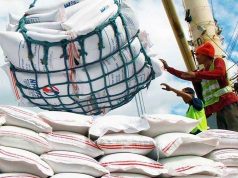Peso to weaken versus dollar as infections go up
THE PESO may continue to weaken against the greenback this week due to the surge in coronavirus infections which has forced the government to tighten restriction measures anew.
The local unit finished trading at P48.62 per dollar on Friday, appreciating by six centavos from its P48.68 close on Thursday, based on data from the Bankers Association of the Philippines. However, it shed 16.5 centavos from its P48.455-per-dollar close a week earlier.
The peso’s climb on Friday was supported by the downward correction in oil prices, Rizal Commercial Banking Corp. (RCBC) Chief Economist Michael L. Ricafort said.
Meanwhile, UnionBank of the Philippines, Inc. Chief Economist Ruben Carlo O. Asuncion said the increase in daily COVID-19 cases drove market sentiment last week.
For this week’s peso-dollar trading, Mr. Asuncion said he expects investors to continue monitoring new infections.
The Philippines on Saturday logged 7,999 new cases, the highest daily increase since the pandemic started. This brought the tally to 656,056, of which 80,642 are active cases.
He added that a continued increase in US benchmark yields could also fuel risk-off sentiment that could cause the peso to weaken against the greenback.
US Treasury yields have been picking up in past weeks, with the benchmark 10-year notes and 30-year papers on Thursday fetching their highest yields since January 2020 and August 2019, Reuters reported. However, they marginally retreated by Friday due to the decline in oil prices.
For his part, RCBC’s Mr. Ricafort said the market will also watch out for the local central bank’s policy decision on Thursday for further signals on inflation expectations.
A BusinessWorld poll held last week saw 19 analysts expecting central bank policy makers to maintain the key rate at its all-time low of 2% at their meeting this Thursday. They said lower rates and fiscal measures from the government are increasingly necessary amid a supply side-driven spike in inflation.
The Bangko Sentral ng Pilipinas’ (BSP) Monetary Board left benchmark interest rates untouched at its Feb. 11 meeting but raised its inflation forecast for this year to 4% from 3.2% previously due to rising oil prices. The central bank last year slashed rates by 200 basis points to provide support to the virus-stricken economy.
Headline inflation stood at 4.7% in February, picking up from 4.2% in January 2021 and 2.6% in February 2020, the government reported earlier this month. It was also the fastest pace since the 5.1% print in December 2018.
Year to date, February inflation settled at 4.5%, beyond the BSP’s 2-4% target for the year.
BSP Governor Benjamin E. Diokno said earlier this month that the central bank is not inclined to tighten monetary policy yet as they see the uptick in inflation as “temporary,” with pressures coming from the supply side.
For this week, Mr. Ricafort gave a forecast range of P48.50 to P48.70 per dollar while Mr. Asuncion expects the peso to move within a wider band of P48.50 to P48.50 versus the dollar. — L.W.T. Noble with Reuters



